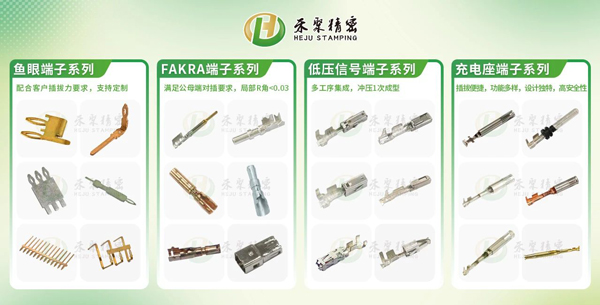Precision Metal Stamping: A Core Process for Superior Automotive Terminal Performance
In the “neural network” of an automotive electrical system, every terminal is a critical node ensuring stable signal and power transmission. With the rapid evolution of vehicles toward electrification and intelligent technology, these seemingly tiny yet crucial connection components are facing unprecedentedly high standards: extremely high reliability, millimeter-perfect precision, and large-scale consistency. Precision metal stamping is the preferred process for manufacturing high-end automotive terminals, meeting all these requirements.
Why do Top Automakers Rely on precision Stamped Terminals?

Micron-level Precision Ensures Absolute Reliability of Electrical Connections
The core mission of automotive terminals is to establish and maintain stable, low-resistance electrical connections. Precision metal stamping, leveraging sophisticated progressive die technology, integrates multiple processes—including blanking, forming, and finishing—in materials like copper and copper alloys within a single die set. This ensures that each terminal maintains dimensional tolerances of ±0.01mm or even tighter.
This extreme precision means:
- Zero Insertion and Removal Failure
Perfect fit with the mating connector, eliminating poor contact, excessive insertion and removal force, or loosening caused by dimensional deviation.
- Stable Contact Resistance
Precise molding ensures consistent surface pressure and area across the terminal contact area, maintaining low and stable contact resistance and reducing energy loss and heat generation.
- Excellent Signal Integrity
In high-speed data transmission (such as in-vehicle Ethernet and camera signals), terminal geometry directly impacts signal quality. Precision stamping ensures consistent impedance control.
Superb Material Property Control and Consistency
Automotive terminals must operate for decades in harsh environments such as severe vibration, temperature cycling (-40°C to +125°C or even higher), and chemical corrosion. The precision stamping process not only shapes the material but also precisely controls the metal fiber flow and mechanical properties of the material.
Precise pre-bending, stress relief, and elastic forming during the stamping process produce a flexible contact arm with excellent normal force. This self-elastic force is fundamental to the long-term contact reliability of the terminal, ensuring it does not relax throughout the vehicle’s lifecycle. The high repeatability of the precision stamping process ensures absolutely consistent performance across millions of products, a feat unattainable with traditional processing methods.
Unparalleled Production Efficiency and Cost-Effectiveness
A modern vehicle contains hundreds or even thousands of electrical connection points, meaning each model requires millions of terminals. Precision metal stamping is the only solution for achieving this large-scale, highly efficient production.
- High-Speed Production
High-speed stamping machines combined with progressive dies can produce thousands of complete terminals per minute.
- Extremely Low Scrap Rate
Highly automated production combined with an online CCD (Computer-Assisted Device) vision inspection system monitors the stamping process in real time, ensuring near-zero defect output and significantly reducing quality costs.
- Maximized Material Utilization
Precision nesting maximizes coil material utilization and minimizes scrap, meeting the automotive industry’s stringent cost control requirements.
Integrated Molding of Complex Structures Enhances Functional Integration
Modern automotive terminal designs are becoming increasingly complex, often integrating multiple functions such as a locking arm (primary lock), a secondary locking mechanism, a waterproof seal ring retaining groove, and a stress relief mechanism. Precision progressive stamping allows these complex features to be perfectly formed in a single mold, achieving true “integrated molding.” This eliminates potential failure points associated with multi-part assembly and improves overall structural strength and reliability.
Key Considerations for Selecting an Automotive Terminal Stamping Supplier
Selecting a terminal supplier for an automotive project involves more than simply comparing prices; it is crucial to examine their comprehensive capabilities:
- Industry Certifications and Quality Systems
Does the supplier have IATF 16949 certification? Does it comply with relevant VDA 6.3 or AIAG standards? These are key factors in establishing a foothold in the automotive supply chain.
- Strong Tool R&D Capabilities
Tooling is the soul of precision stamping. Suppliers must possess independent tool design, processing, commissioning, and maintenance capabilities, and tool life should exceed 100 million stamping cycles.
- Comprehensive material knowledge
Are you familiar with the properties of various high-performance copper alloys (such as C5191, C2680, and C7025)? Can you provide material selection recommendations based on different application scenarios (e.g., high current, high-frequency signals)?
- Strict testing and verification capabilities
The supplier should have a comprehensive laboratory capable of conducting insertion and extraction force tests, contact resistance tests, salt spray tests, temperature cycling tests, vibration tests, and other tests to verify that terminals meet stringent standards such as USCAR.
Conclusion
Amid the wave of automotive electrification, precision metal stamping is no longer simply “blacksmithing.” Instead, it is a high-tech technology that integrates materials science, precision mechanical engineering, and digital quality control. It is the cornerstone for ensuring that every automotive terminal—the “nerve endings”—operates accurately, reliably, and durably. For automakers and Tier 1 suppliers, choosing a precision stamping partner with a deep technical background is a strategic decision that will give them a competitive edge in the future.
